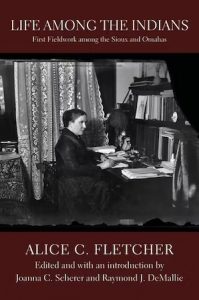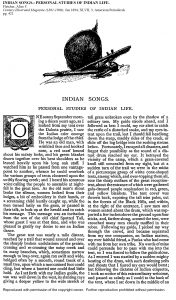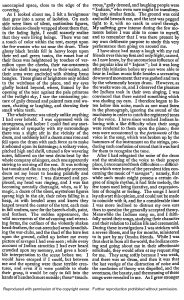
Fletcher’s fieldwork collection from observing Sioux and Omaha Native Americans.1
Alice C. Fletcher is thought to be the first scientist of ethnology to live among the Native Americans in the 1880s.2 In this excerpt of an article written by Fletcher, she details her time observing a ceremony done by the Native Americans she was living with. She continues by explaining every detail of what she sees and how she feels throughout the duration of this event.
Fletcher page 1 Fletcher page 2
One of Fletcher’s first feelings upon entering this tent and seeing the ceremony is one of fear. She was “startled by a sudden mighty beating of the drum, with such deafening yells and shouts that [she] feared [her] ears would burst.”3 She describes the women sitting around the drum as being the only people wearing color. She details the bangles they wear around their wrists as “glints of brightness” which “only added to the weirdness of the place.”4 Fletcher’s vocabulary usage in her descriptions throughout this article excerpt insinuates a sense of “othering” between her and the ceremony. The impression she gives the reader is one of fear, where the reader might want to be wary of Native Americans and their music.
Fletcher moves on to discuss the music she hears. She states that she was “distressed and perplexed, [her] head was ringing, and [she] was fast becoming mentally distraught.”5 The visuals of the ceremony, the dancing and singing, lead her to call upon “every picture of savages [she] had ever seen,” as well as “every account of Indian atrocit[y] [she] had ever heard,” and it “gave her a horrible interpretation to the scene.”6 So much so that she would have escaped if she could. Eventually, she states that she comes to her senses and realizes that she was witnessing this very ceremony by her own choice, and she needs to put her personal emotions aside.
Fletcher admits it took her a long time for her ears to adjust to what she was hearing. She even acknowledges that the Native Americans struggled to listen to their music when played on a piano.7 They were not accustomed to the piano the same way Fletcher was not accustomed to their singing. It wasn’t until she fell ill and the Native Americans sang to her that she finally began to understand the beauty of their music.
It is really easy to discuss other culture’s music in a way that makes it seem so far away from us. It is so easy to “other” their music as seen here in the way Fletcher writes about how she felt while experiencing their ceremony. Fletcher’s feelings demonstrate exactly why there is misunderstanding and misrepresentation of Native American music. People begin with a preconceived idea and understanding that it makes it difficult to learn about and appreciate local and global music for what it is.
Bibliography
“Alice Cunningham Fletcher.” History of American Women, April 2, 2017. https://www.womenhistoryblog.com/2015/05/alice-cunningham-fletcher.html.
Fletcher, Alice C. “INDIAN SONGS.: PERSONAL STUDIES OF INDIAN LIFE.” Century Illustrated Magazine (1881-1906) XLVII, no. 3 (01, 1894): 421, 1-2, https://www.proquest.com/magazines/indian-songs/docview/125523852/se-2.
“Life among the Indians.” Nebraska Press, January 27, 2017. https://www.nebraskapress.unl.edu/nebraska/9780803241152/.
1https://www.nebraskapress.unl.edu/nebraska/9780803241152/


